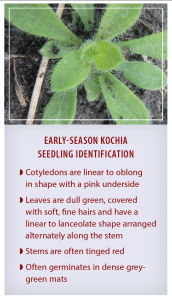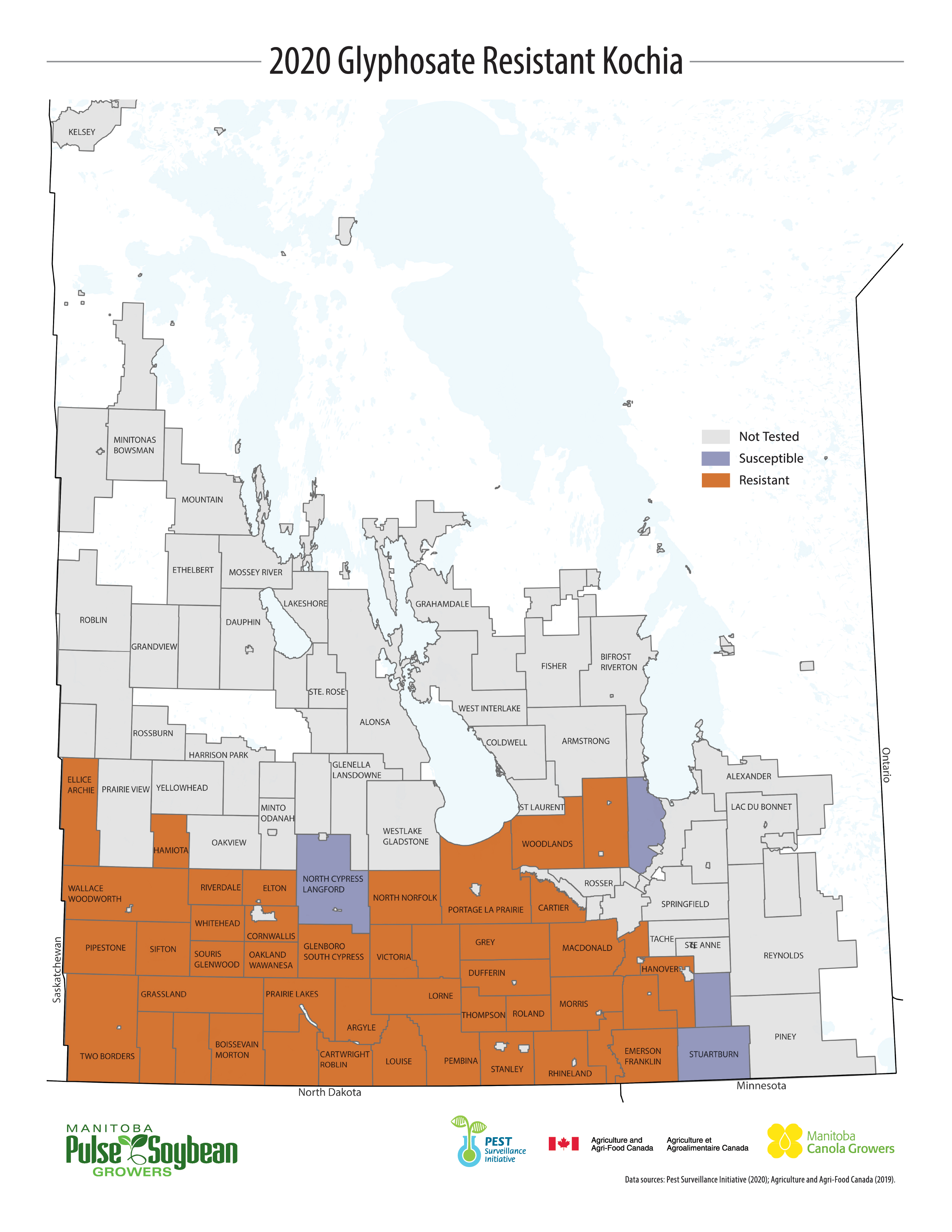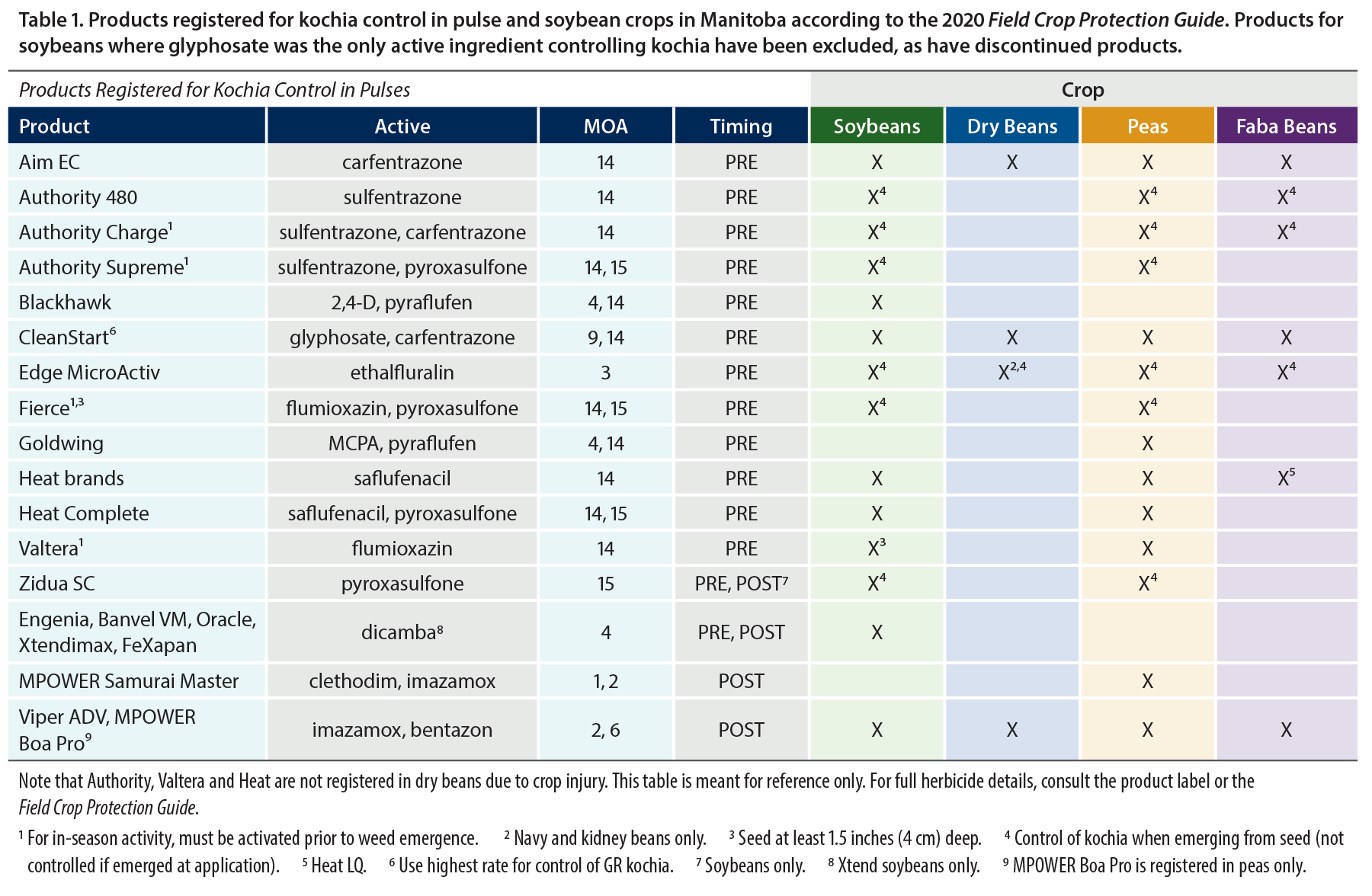Laura Schmidt, PAg, MSc, Production Specialist – West, MPSG – Spring 2021 Pulse Beat
Pulse and soybean farmers are no strangers to kochia. It tolerates salinity, while our crops do not, leaving those marginal areas of the field open for kochia to populate.
Kochia is an early germinator, meaning we have larger, more competitive plants to control at spray timing. Most herbicides are only effective when kochia is small (<4″).
It thrives in dry conditions. As it gets drier, the cuticle grows thicker, it develops more hairs and the stomates close. All of these things mean it’s tougher for herbicides to enter the plant’s system and do their job.
And even when we get those herbicides into the plant’s system, we have herbicide resistance to contend with. Group 2 herbicide resistance (imazamox) is common in kochia, group 4 (dicamba, fluroxypyr) resistance is known in other regions and group 9 resistance (glyphosate) has been a real up-and-comer over the last five years.
One weed emerging one week before the crop will have the same effect on yield as 100 weeds emerging three weeks after the crop.
– Harker and O’Donovan
Status of Herbicide-Resistant Kochia
Survey data from Agriculture and Agri-Food Canada (AAFC), as well as individual qPCR plant tests from submitted samples to the Pest Surveillance Initiative (PSI), have given us a window into the status of herbicide resistance of kochia in Manitoba (Figure 1). In 2013, kochia seed was sampled from 283 sites in southern Manitoba and grown out in the greenhouse to test for herbicide resistance. This same survey was repeated five years later in 2018, where samples were taken from 297 fields. To add to this data set, PSI has tested 279 kochia plant samples suspected of glyphosate resistance (GR) from 2015 to 2020.
All of the kochia samples from the 2018 survey were resistant to group 2 herbicides. Group 4 resistance to dicamba and/or fluroxpyr was present in Saskatchewan, but has not been confirmed in Manitoba yet. Those samples are still being processed due to COVID-19 related delays. As dicamba use in Xtend soybeans increases, we can expect kochia resistance to this mode of action to increase.
Over the course of just five years, glyphosate resistance has spread throughout Manitoba’s kochia populations. In 2013, 1% of kochia populations sampled were resistant to glyphosate. In 2018 that number rose to 59%. It’s now more likely that uncontrolled kochia populations are GR than susceptible.
Kochia collected from Roundup Ready (RR) soybean and RR corn fields had a greater percentage of resistance, where, respectively, 77% and 70% of the kochia populations were GR. Comparatively, in RR canola, a more competitive GR crop than corn and soybeans, 53% of the kochia population was resistant. GR kochia was also found in cereals (48%), in other crops (53%) and in uncropped areas (21%).
The mechanism of glyphosate resistance in kochia is gene amplification of the EPSPS gene that glyphosate targets. Kochia overcomes glyphosate by producing multiple copies of this gene. The PSI lab’s qPCR test can rapidly identify how many copies of this gene a kochia plant has, giving us an indication of how resistant the individual plant is. Plants with one copy of the gene are still susceptible, those with two to nine copies have intermediate resistance and those with more than ten are considered resistant.
PSI typically only receives kochia samples if resistance is already suspected, with quite a few samples coming in from the RMs of Pembina, Louise, Two Borders and Montcalm. Of the 270 samples they have tested in the last five years, 44% were fully resistant, 39% had intermediate resistance and 16% were still susceptible. These susceptible plants were submitted either to validate that a kochia patch had different levels of resistance, or to determine if the problem was due to other factors. In the GR plants, 40% produced more than 20 copies of the EPSPS gene. One plant sampled in the RM of Pembina in 2019 had 100 copies of this gene.
Herbicide Options for Kochia Control
Herbicides won’t be the solution to solving herbicide resistance. Herbicides are part of an integrated weed management strategy — remember that they’re not the only tool we need to use to manage kochia. Kochia has a massive seed set (14,000–30,000 seed/plant), but also only lasts about one to two years in the weed seedbank. This is something we can exploit to help us manage kochia. A key component will be to not let this weed go to seed.
To start working on a kochia strategy, let’s take a look at our limited herbicide options (Table 1). We can assume our kochia populations will be resistant to the group 2 imazamox in our post-emergent herbicides.
Pre-emergent kochia management is especially important. We want to use soil-applied and/or spring burndown products with residual activity and consider a tillage pass over early flushes. The bulk of our pre-emergent options are group 14 and we anticipate that resistance to this group of PPO inhibitors is on the horizon for kochia. Incorporating mechanical weed control here will help reduce the selection pressure on this mode of action.
For groups 14 and 15 we need moisture to activate the herbicide for uptake by weeds. One option is to consider a fall application where the snowfall will provide that moisture and allow for a more even distribution in the soil following winter.
Post-emergent control is going to be maximized if you target kochia while it’s still small (<4″). As mentioned earlier, kochia is an early germinator, with roughly 60% emergence by early May. Consider incorporating mechanical tools into your integrated weed management strategy post-emergence.
Layer your herbicides using pre-emergent and post-emergent herbicides from different groups. Try not to overuse group 14s and incorporate more modes of action like ethalfluralin (group 3) or pyroxasulfone (group 15) into your pre-seed burndown.
Kochia Control Goals
Take advantage of kochia’s low seedbank persistence and make preventing kochia seed set a priority. Five percent of kochia seeds are viable after one year and one percent after two years. But keep in mind, with a plant that produces 30,000 seeds, one percent is still 300 viable, herbicide-resistant seeds.
Control patches and herbicide escapes. Mow, bale, graze, spot till, burn or hand pull surviving kochia plants before they set seed. Manage marginal areas of the field where your crops aren’t growing but kochia is. For example, if you’re putting fertilizer down in those areas and the crop isn’t growing there, those nutrients are going to the weeds.
Consider crop rotation. Cereals have more effective herbicide options and are a competitive cropping option. Preceding pulse crops with a cereal will help deplete the weed seedbank, meaning there will be less kochia to manage from the start. As it stands right now, 45% of soybeans, 60% of peas and 28% of dry beans are planted into a cereal stubble.
Think about your herbicide plan the fall before growing pulses and consider your pre-emergent options. Maybe a fall application would suit your operations. In-season, manage weeds when they are small.
Maximize crop competitiveness to help take the selection pressure off your herbicides. Narrow up row widths, plant adequate to high plant populations and use appropriate fertility strategies.
Research
On-going research by Dr. Charles Geddes at AAFC-Lacombe is looking into integrated weed management strategies for herbicide-resistant kochia control in pulses. The effect of row spacing, seeding density and crop rotation on GR kochia control with typical kochia herbicides is being investigated. His lab is also exploring pre- and post-harvest management options and determining if managed kochia patches have time to regrow and set seed before winter following the early harvest of peas or winter wheat.

